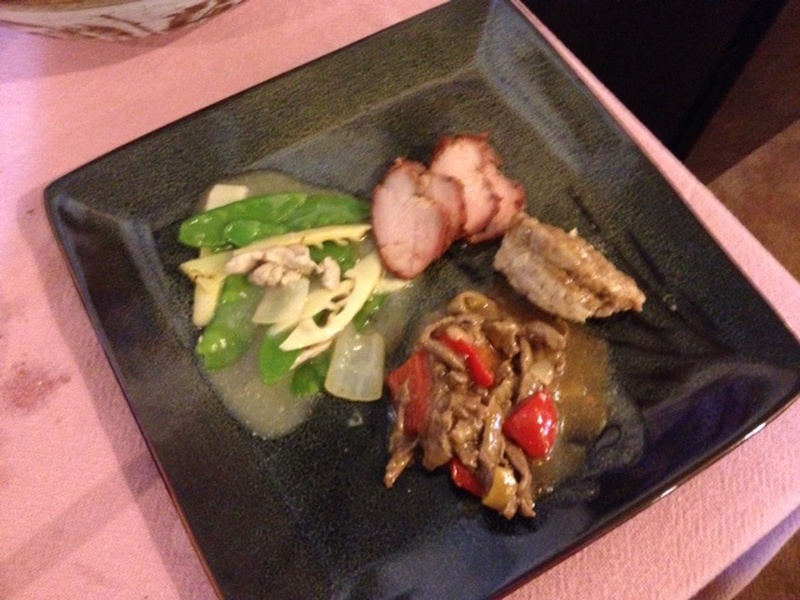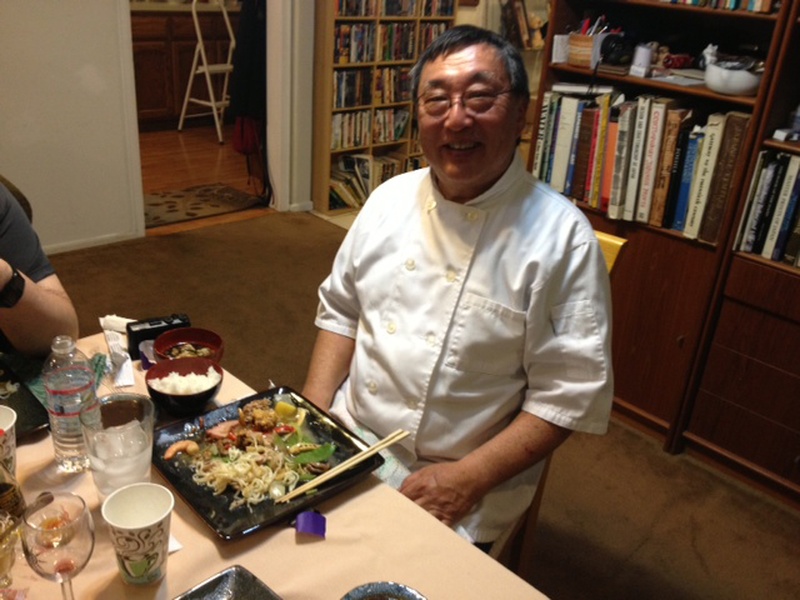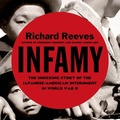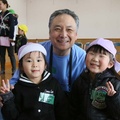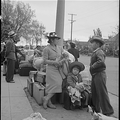We call it “Old School Chinameshi,” this Cantonese version of Chinese food that Japanese Americans have been eating long before WWII, and several decades after. You won’t find it in most Chinese restaurants today—the homyu, the pakkai, the almond duck…But you mention these dishes to Japanese Americans who remember, and all of a sudden mere words conjure up powerful memories of tastes and smells. With these words, come vivid images of a time gone by, of family who have passed, leaving us longing for that special taste, the trigger that will take us back to the way it used to be.
Before the War, the Chinese restaurant provided the Issei and their large families a special outing to look forward to once a month. Located in their local Japantown or nearby Chinatown, going to “Chinameshi” was a “real treat for us,” remembers my mother, Sadako Kashiwagi, who as a child used to go with her family to the Hong Kong Café in Sacramento, California.
But with the Issei and Nisei facing rampant racism and discrimination all throughout their years in America before and after WWII, the Chinese restaurant was also a safe haven, a place where they wouldn’t be turned away, a place that actually welcomed them and became a home away from home. In fact, the restaurant owners appreciated them and their business so much that they catered their food specifically to Japanese American tastes, creating a long-lasting loyalty and family traditions that would last for years.

In Los Angeles’ Little Tokyo, there was the Far East Café, the gold standard of Japanese American Chinese food, the place everyone remembers for its savory, sometimes greasy Cantonese favorites—dishes so frequently enjoyed that the waiters didn’t have to take their orders. They knew the drill, and they delivered.
Going to “Chinameshi” became this tradition, a place to be for wedding receptions, birthday parties, post-funeral family gatherings…until one day, it was gone. Gone was the food, gone was the tradition, and gone was the family and extended family, sitting around the table, eating the same dishes, expressing the same wishes and creating memories together that have lasted a lifetime.
John Nishio, a Sansei friend of mine, remembers. He was just a kid in the ’50s when he and his family went to eat at Far East all the time. He remembers his Jiichan and Baachan, and how his grandfather would buy him Botan Rice candy from the Far East candy counter after every meal. He remembers the private booths with curtains. And of course, he remembers the food, and like a lot of Sansei boomers who grew up eating it, he remembers his family, and those who have passed. But the taste—that taste—brings everything and everyone back to life.
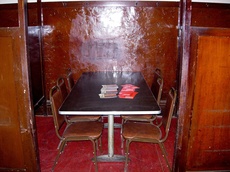
Far East Café in 1978
(Photo courtesy of John Nishio) |
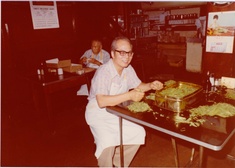
Staff of Far East Café in 1978
(Photo courtesy of John Nishio) |
Ever since the Far East closed after the 1994 Northridge earthquake, John, a 60-something foodie and sushi chef, has spent the better part of 20 years in search of what he calls the “lost flavor” of the Far East Café. Over the years, he’s tried Cantonese restaurants in Arizona, New Mexico, Nevada, Washington, New York, North Carolina, Georgia, Paris, Tokyo, and London, but he’s had “zero luck” in finding that special flavor.
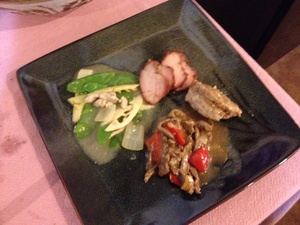
Over the past several years, he’s been trying, on his own, to re-create the Far East Café’s homyu—steamed pork/fish patty—going as far as meeting the chef/owner of a local Cantonese restaurant in his kitchen so he could learn the secret of his homyu recipe. “Here’s what’s in it,” the chef said, “But you have to figure out how to make it on your own.”
“It’s a unique flavor,” said John, in talking about homyu and Chinameshi in general. “It was created by Chinese immigrants catering to Japanese and Japanese Americans, using American and Chinese ingredients.”
Earlier this month and after years of trial and error in his home kitchen, John prepared his Far East re-creations for a small group of Sansei friends who remember the taste and have been searching for it just like he has. He called it the “Far East Feast,” and with the help of his son, Mike, and wife, Susan, they presented a meal that included the following favorites.
John Nishio’s “Far East Feast”
Seaweed Soup
Chashu
Homyu
Pakkai
Chicken Chowmein
Pea chow-yuk
Shrimp with Lobster Sauce
Ginger Beef
(Served with long-grain Chinese rice and Chinese almond cookies and
fortune cookies for dessert.)

The meal opened with Seaweed Soup.
|
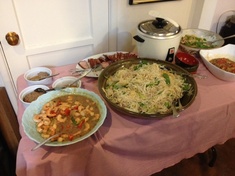
Shrimp with Lobster Sauce and Chowmein
|
Working strictly from memory and taste and without any recipes, John whipped up the meal on two woks in his home kitchen and presented the food buffet-style in his dining room/living room. One of the first dishes to come out was the homyu, the favorite dish of Issei grandfathers, Nisei uncles, and Sansei sons.
As we savored the moistness of the meat, my friend leaned over to me and said, “This is really good, but I remember it being a lot greasier.” Others around the table remembered the same thing; in fact, some recalled the fatty patty literally “swimming in grease.” But now that we’re older and need to watch our diets, we thought the dish was fine “as is” and we all agreed that we could do without the grease.
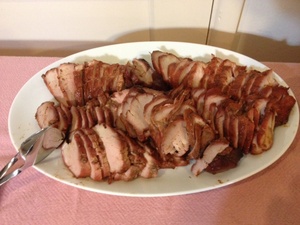
Our guest diners shared other notes such as the lack of the deep orange food coloring used in the pakkai, aka “sweet and sour pork.” But overall, the meal—and the memories it brought back—was thoroughly enjoyed by all.
One guest posted food photos on his Facebook wall, and after listing the entire “old school Chinese Cantonese” dinner menu, he wrote: “Soji Kashiwagi invited me to this taste testing dinner and I’m so happy he did.” For him, this dinner was so special it was like “Christmas in June.”
Other guests wrote long thank you notes and emails to John afterwards, telling him in great detail how much they enjoyed the experience and how he “nourished both their bodies and their souls” with his food.
They also thanked him for the pre-dinner tour of his Japanese garden he built in his backyard, saying that along with preserving the foods from their childhood, they really appreciated how he is preserving Japanese culture as well. Two guests mentioned the serenity they felt while in the garden, and how it brought out long-suppressed and deep feelings for their Japanese roots.

For John, to hear comments like this is his greatest reward as he has made Japanese American cultural preservation a personal mission ever since he noticed that members of his own family knew little to nothing of their family history and Japanese roots. Over the past several years, he has put together a family “roots” DVD documenting his family tree going back over 200 years. He has also resurrected the annual family mochitsuki, where family members experience the fun of making mochi, eat an enormous amount of Japanese food (prepared by John), and receive the latest version of the family DVD.
“To know where you are going, you must first know where you come from,” is a saying that really resonates with John. And so, with the tastes he re-created with his “Far East Feast,” he truly took us back to one of the special places where we as Japanese Americans come from. While we agreed before the dinner it would be impossible to re-create the exact tastes of the Far East, the “kimochi” (feeling) and sincerity in John’s dishes spoke to us all. As we savored the flavors, all of a sudden Obaachan Nimura was back at the table, laughing and enjoying the pea chow-yuk, and there was Auntie Nesan, talking story over pakkai, and our family was around the table, together again.
© 2015 Soji Kashiwagi






